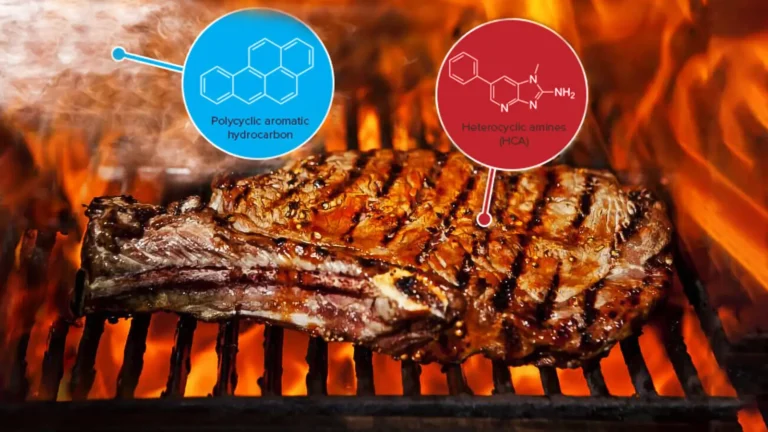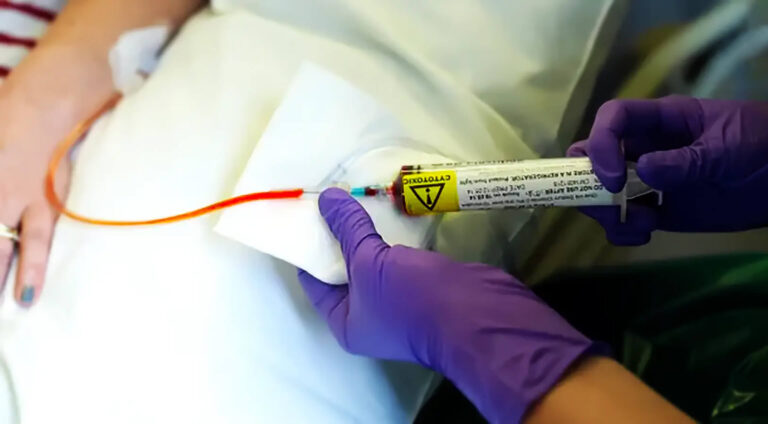Can You Eat Mushrooms Raw: Health Risks, Nutrition & Safety
Mushrooms have heat-sensitive toxins like hydrazine or agaritine, and cell walls made out of chitin that cannot be digested well by humans.
Milos Pokimica
Written By: Milos Pokimica
Medically Reviewed by: Dr. Xiùying Wáng, M.D.
Updated January 6, 2024Key Takeaways:
– Chitin makes up the cell walls of mushrooms, which are hard to break down.
– Cooking mushrooms helps break down their cell walls and release their valuable compounds.
– Cooking shiitake mushrooms increased their antioxidant levels and activity.
– Some species of mushrooms are poisonous, some have mind-altering properties, some are toxic when uncooked and some are safe in any form.
– Button mushrooms contain a substance called agaritine, which is a type of phenylhydrazine. Some studies on mice have suggested that agaritine might cause cancer and that eating raw mushrooms might be bad for your health.
– Cooking the mushrooms reduced the agaritine content but to a different extent depending on the method.
– In normal cooking with white button mushrooms, agaritine is not present in the amounts needed to increase cancer risk.
– Eating raw or undercooked Shiitake mushrooms can cause a very unpleasant skin reaction called flagellate dermatitis.
– Some mushrooms contain chemicals that can cause cancer in animals and humans.
– Morel mushroom has hydrazine analogs that are severely toxic and should not be eaten raw.
– Hydrazine can also cause stomach cramps, diarrhea, and vomiting if consumed raw.
– The second mushroom that contains hydrazine analogs is the common button mushroom, Agaricus bisporus. They contain small amounts of up to 0.04% of hydrazine analogs.
– There are several ways that contamination can be introduced to raw mushrooms like improperly sterilized compost or manure, contact with animals, or cross-contamination.
Can Humans Digest Raw Mushrooms?
Can You Eat Mushrooms Raw? The short answer is: It depends on the mushroom. However, even if you do, you would only be getting fiber and not much of the rest of the nutrition.
Chitin is a hard and sturdy material that gives insects, crabs, and other crawlies their protective shells. You can find chitin in some foods, such as seafood.
Chitin also makes up the cell walls of mushrooms, which are hard to break down as a consequence.
But can you digest it?
For a long time, people thought that chitin was indigestible for humans. But it turns out that we have some special enzymes in our bodies called chitinases. These enzymes help us fight off parasites that have chitin in them (Paoletti et al., 2007).
However, our chitinases are not very good at digesting chitin from food sources. They are more a defense mechanism than a digestive aid. That means that eating raw mushrooms won’t give you much nutrition. Raw mushrooms will just add some fiber to your diet, which can be good for your gut health.
You can think of chitin in mushrooms as similar to cellulose in plants. Both are types of fiber that can help you feel full and regulate your bowel movements.
If you want to lose weight or increase your fiber intake, then eating raw mushrooms can be a smart choice. But don’t expect to get much of the other benefits that mushrooms have to offer.
If you want to unlock the nutritional and medicinal potential of mushrooms, you need to cook them.
Cooking mushrooms helps break down their cell walls and release their valuable compounds.
These compounds include antioxidants, vitamins, minerals, and even some substances that can boost your immune system and fight cancer.
Summary:
Though some raw mushrooms are safe to eat, their chitin content restricts nutritional benefits to mainly fiber. Cooking mushrooms unlocks their full potential for vitamins, minerals, antioxidants, and other health-promoting compounds.
Are Mushrooms Healthier Raw or Cooked?
Mushrooms are not only delicious but also good for your health. They have antioxidants that can protect your cells from damage caused by free radicals. Mushrooms also have specific chemicals that can fight off cancer, increase our immunity, and help with different diseases.
But what happens when you cook mushrooms? Do they lose their antioxidants and health benefits?
That’s what researchers in this study (Choi et al., 2006) wanted to find out. They took raw shiitake mushrooms and heated them at different temperatures and times. Then they measured how much antioxidants they had left in them. They also tested how well they could fight off free radicals in a lab.
Researchers were surprised to see that cooking shiitake mushrooms actually increased their antioxidant levels and activity.
The hotter and longer we cooked them, the more antioxidants they had. For example, the shiitake mushrooms that were cooked at 121 °C for 30 minutes had almost twice as many antioxidants as the raw ones. They also did a better job at neutralizing free radicals. There was a strong link between the amount of antioxidants and the ability to fight off free radicals.
This is a consequence of chitin degradation. The overall level of antioxidants might dropped and be degraded due to heat but the chitin was degraded as well. Degradation of chitin at the end increased the bioavailability of antioxidants in mushrooms and this is what is important. It is not what we eat but what we absorb that matters.
This means that you don’t have to worry about losing the health benefits of mushrooms when you cook them. In fact, you may get even more benefits from them.
Cooking mushrooms can make them more tasty, tender, and aromatic, as well as more nutritious and protective.
Summary:
While cooking might decrease overall antioxidant levels in mushrooms, it breaks down chitin, significantly boosting the bioavailability and health benefits of the remaining antioxidants, so cook your mushrooms for increased nutritional value.
Are All Mushrooms Safe To Be Consumed Raw?
Raw mushrooms can contain harmful pathogens and heat-sensitive toxins that can harm your health.
Raw mushrooms can cause damage to your red blood cells (Shibata et al., 2010), irritate your stomach and intestines, and trigger allergic reactions like skin rashes (Fang et al., 2017).
Not all mushrooms are the same. It varies from species to species.
Some species of mushrooms are poisonous, some have mind-altering properties, some are toxic when uncooked and some are safe in any form. However when we eat raw mushrooms there also might be a risk of contamination with dangerous pathogens if they are not handled properly.
So, how can you enjoy mushrooms without risking your health? The answer is simple: cook them well. Cooking mushrooms does more than just kill the bad stuff. It also breaks down the tough fungal tissues and releases nutrients.
But to get these benefits, you need to cook mushrooms properly. According to Choi et al., 2006, edible mushrooms should be heated to at least 140 ˚F for 3 to 4 hours, or better yet, over 180 ˚F, or best of all, above 200 ˚F. This will make them tender, digestible, and safe.
Summary:
Raw mushrooms can harbor not just harmful toxins but pathogens as well. Thorough cooking kills microorganisms, breaks toxins down, releases nutrients, and makes them safe and even more digestible.
White Button, Cremini and Portobello.
There are over 2000 kinds of edible mushrooms, but only about 30 are grown or sold commercially. The most common one is the button mushroom.
Eating raw white button mushrooms is the same as eating raw cremini mushrooms or eating raw portobello mushrooms. There is no difference. All of these mushrooms are the exact same mushroom Agaricus bisporus. They are harvested at different stages of growth. White button mushrooms are the youngest and if left will become brown cremini mushrooms. Cremini is the middle-aged white button mushroom. Portobellos, which are much larger and brown are at the end stage of development and are fully matured.
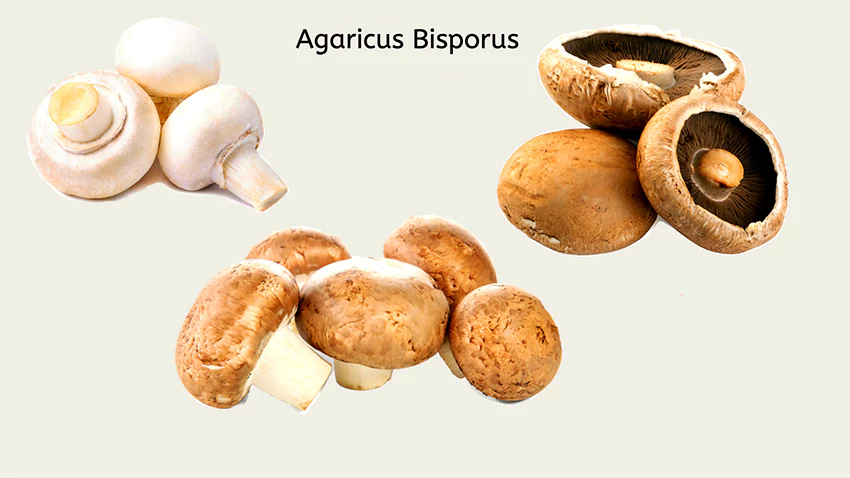
But there is something you should know about button mushrooms.
Button mushrooms contain a substance called agaritine, which is a type of phenylhydrazine. Some studies on mice have suggested that agaritine might cause cancer and that eating mushrooms might be bad for your health.
Researchers did an experiment with special mice called lacI mice, or Big Blue mice (Shephard et al., 1995). These mice have a gene that can change color when it mutates, which makes it easy to measure the mutagenic potency of different substances. The researchers fed the mice three different diets for 15 weeks: (1) fresh mushrooms three times a week and normal food for the rest of the week; (2) freeze-dried mushrooms mixed with normal food; or (3) a mushroom extract with a high concentration of agaritine mixed with normal food.
Then they checked the DNA of different organs of the mice for changes in the color of the lacI gene. They called this the mutant frequency (MF).
Only the mushroom extract with a high dose of agaritine had a significant effect on the MF. It increased it by 100% in the kidney and 50% in the forestomach. The other two mushroom diets, with lower doses of agaritine, had no significant effect on the MF, except for a slight increase in the kidney. This means that agaritine was weakly genotoxic in vivo, meaning that it could cause mutations in living organisms. But it also means that there was no other genotoxic activity in the button mushroom, apart from agaritine.
The researchers used a formula to estimate the cancer risk of agaritine in mushrooms based on the MF data. They calculated that the average Swiss mushroom consumption of 4 g/day would result in a lifetime cumulative cancer risk of about two cases per 100,000 lives. This is for raw mushrooms however people usually don’t eat mushrooms raw.
So, what does this mean for you? It means that you don’t have to worry too much about eating button mushrooms raw. They are not very mutagenic.
But it also means that you should be careful about eating too much agaritine, which could be potentially found in high amounts in white mushroom extracts or supplements. Agaritine can cause mutations in DNA, especially in the kidney and stomach. This could increase your risk of cancer over time.
In a human study that followed 68,327 women and 44,664 men for up to 26 years (Lee et al., 2019), researchers measured mushroom consumption and risk of total and site-specific cancer. These people were all healthy and did not have cancer when the study started. They answered questions about how often they ate mushrooms and other foods, as well as their lifestyle and health habits. The researchers then tracked how many of them developed cancer over the years.
The people who ate five or more servings of mushrooms per week did not have a lower risk or higher risk of total cancer than the people who hardly ate any mushrooms. The same was true for 16 different types of cancer, such as breast, prostate, colon, and skin cancer. There was no evidence that mushrooms had any protective effect against these cancers.
Most people usually eat button mushrooms or other commercial types and do not consume functional mushrooms which are much more expensive and sold as supplements. Some of the functional mushrooms have proven anticancer benefits.
This study shows that in normal cooking with white button mushrooms, agaritine was not present in the amounts to increase cancer risk. We don’t need to worry if we eat button mushrooms in pasta or pizza or some other way that does not have adequate cooking time or temperature.
Summary:
Button mushrooms, though containing a potentially cancer-linked compound called agaritine, pose minimal risk due to low levels and weak mutagenic activity. However, be cautious of high-dose mushroom extracts or supplements and ensure thorough cooking for any other mushroom varieties.
Cooking And Agaritine.
How much agaritine is actually in the mushrooms that we eat? And how does the amount change when we store or cook them?
These are some of the questions that researchers in this study tried to find out (Schulzová et al., 2002). The researchers analyzed fresh and processed samples of A. bitorquis and A. garicus hortensis mushrooms from different sources and found that the agaritine content varied widely depending on several factors. Here are some of their findings:
- Freshly harvested mushrooms from early flushes (the first batches of mushrooms that grow) had relatively high levels of agaritine, but samples from supermarkets had less agaritine.
- The agaritine content was not evenly distributed in the mushrooms. The highest amounts were found in the skin of the cap and in the gills, while the lowest were found in the stem.
- Storing the mushrooms in the refrigerator or freezer, or drying them, reduced the agaritine content significantly. The degree of reduction depended on the length and condition of storage and was usually between 20% and 75%.
- Cooking the mushrooms reduced the agaritine content but to different extents depending on the method.
- Boiling extracted around 50% of the agaritine into the broth within 5 minutes and degraded 20-25% of it in total. The rest of the agaritine was left in the liquid so making quick soups or sauces could be a problem. Prolonged boiling reduced the agaritine content even further (only around 10% left in the mushrooms after 1 hour). If you boil mushrooms throw away the water.
- Baking in the oven, like when making a pizza, reduced the agaritine content by about 23%.
- Frying in oil or butter or deep frying reduced it by 50%.
- Microwaving the mushrooms reduced the agaritine content to one-third of its original
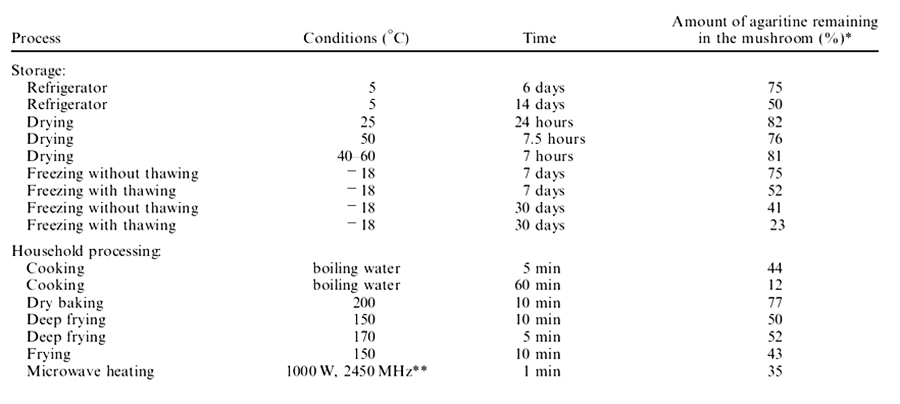
Shiitake Mushrooms.
Shiitake mushrooms are a type of wood-grown mushrooms that are popular in Japanese and Chinese cuisine. They are the second most widely consumed edible mushrooms in the world, with an estimated annual production of over 10,000 tons.
But they are not just tasty and nutritious. They also have some amazing health benefits, such as lowering blood pressure, cholesterol, and cancer risk. That’s why Shiitake mushrooms are a big deal in traditional Asian medicine.
But before you rush to the nearest supermarket or Asian grocery store to buy some Shiitake mushrooms, there is something you should know.
Eating raw or undercooked Shiitake mushrooms can cause a very unpleasant skin reaction called flagellate dermatitis.

This is a rare condition, 2% of people are susceptible, which causes itchy, red, and blistered stripes on your skin, resembling whip marks. It usually appears 24 to 48 hours after eating the mushrooms and can last for days or weeks. The most common areas affected are the trunk, arms, legs, and neck, but sometimes the face or scalp can also be involved.
You might be wondering why this happens. Well, the culprit is a substance called lentinan, which is a type of polysaccharide found in Shiitake mushrooms. Lentinan has some anti-inflammatory and anti-tumor properties, which is why it is used as an adjuvant therapy for cancer patients in Japan. However, lentinan also stimulates the production of a chemical called IL-1, which causes inflammation and blood vessel dilation. This may explain why some people develop flagellate dermatitis after eating Shiitake mushrooms.
The treatment for flagellate dermatitis is mainly symptomatic. This means that you can use topical creams or ointments to soothe the itching and inflammation, such as corticosteroids or antihistamines. You can also take oral antihistamines or painkillers if needed.
However, the best way to prevent flagellate dermatitis is to avoid eating raw or undercooked Shiitake mushrooms altogether. Even if you cook them well, you may still have a chance of developing the condition if you are sensitive to lentinan. Therefore, it is advisable to stay away from Shiitake mushrooms if you have had flagellate dermatitis before or if you have a history of allergies or asthma.
Summary:
Though delicious and health-promoting, raw or undercooked Shiitake mushrooms can trigger a rare, whip-like skin rash in susceptible individuals. Opt for thorough cooking or avoid Shiitake altogether if prone to allergies or flagellate dermatitis.
False Morel Mushroom.
Some mushrooms contain chemicals that can cause cancer in animals and humans.
The first one is the false morel mushroom, also known as Gyromitra esculenta. This is a wild mushroom that looks like a brain or a sponge. It grows in temperate regions of Europe, Asia, and North America. Some people eat it as a delicacy, but they have to cook it very well to remove the toxins.
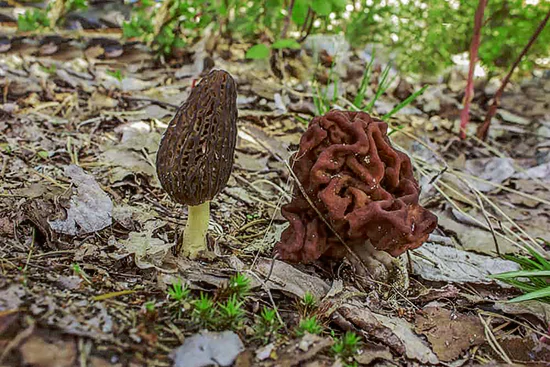
What are these toxins? Well, they are called hydrazine analogs, which means they have a similar structure to hydrazine, a highly reactive and explosive chemical used in rocket fuel. These hydrazine analogs can damage your liver and cause cancer.
Scientists have done experiments with hydrazine on mice and hamsters. Most of the animals developed tumors in their livers and other organs (Spencer & Kisby, 2021).
Hydrazine can also cause stomach cramps, diarrhea, and vomiting if consumed raw.
This toxin is destroyed by cooking, so you should always cook morels before eating them. Cooking also improves their flavor and texture, which are nutty, earthy, and meaty.
If you want to eat morels, you should also make sure they are clean and fresh. You can rinse them under cold water and soak them in salt water overnight to remove any dirt or insects. You should also avoid drinking alcohol while eating morels, as it may increase the toxic effects of hydrazine.
The second mushroom that contains hydrazine analogs is the common button mushroom, Agaricus bisporus. They contain small amounts of up to 0.04% of hydrazine analogs.
You should be careful when eating mushrooms that contain hydrazine analogs. You should avoid eating raw or undercooked false morel mushrooms at all costs. You should also cook button mushrooms well before eating them.
Summary:
Hydrazine analogs in certain mushrooms, notably false morels, pose cancer risks. Be aware that even button mushrooms contain small amounts of hydrazine. Thorough cooking destroys these toxins, so cook your mushrooms well, especially wild varieties like morels.
What Mushrooms Can You Eat Raw?
Not all mushrooms are created equal. Some mushrooms are poisonous, some are medicinal, and some are just plain delicious. How do you know which ones you can eat raw and which ones you need to cook? Let me give you some tips.
First of all, never eat a mushroom that you don’t know what it is. You might think you are picking a tasty treat, but you could end up with a nasty surprise. Some mushrooms are so toxic that they can kill you or make you very sick even after cooking them. For example, the death cap mushroom looks like an innocent white mushroom, but it contains a deadly toxin that can destroy your liver. So always be careful and do your research before eating any wild mushrooms.
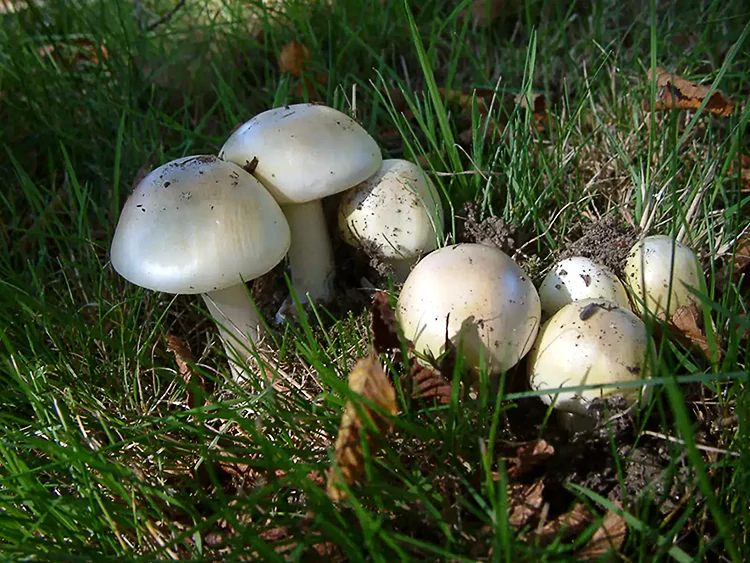
Secondly, some mushrooms are edible but not very palatable when raw. They are either too tough, too bitter, or too bland to enjoy without cooking them.
For example, reishi mushrooms are a type of medicinal mushroom that has many health benefits, such as boosting your immune system and fighting inflammation. But they are also very hard and woody, so you can’t just bite into them. They need to be dried and ground into powder or extracted into tea or tincture.
Another example is honey mushrooms, which are also known as armillaria or bootlace mushrooms. They are a common edible mushroom that grows in clusters of wood. But they are also unsafe to eat raw because they can cause stomach cramps, nausea, and vomiting. You need to cook them well to get rid of the toxins and make them more digestible.
Other edible mushrooms that are better cooked than raw include boletus mushrooms, such as porcini or penny bun. These are prized gourmet mushrooms that have a rich and nutty flavor. But they are also very dense and chewy when raw, so you need to cook them to soften them and bring out their aroma.
Some mushrooms are safe and tasty to eat raw, but only if you prepare them properly. You need to wash them thoroughly and check them for any dirt, bugs, or mold before eating them raw.
There are several ways that contamination can be introduced to raw mushrooms like improperly sterilized compost or manure, contact with animals, or cross-contamination.
There’s naturally a greater risk of food poisoning or digestive issues when eating mushrooms raw. You also need to store them in a cool and dry place to prevent spoilage.
Summary:
While some edible mushrooms are safe raw, thorough washing and proper storage are essential to avoid contamination. Furthermore, wild mushroom identification is crucial for safety, as some are deadly even when cooked. Always prioritize caution and proper identification before consuming any wild mushroom, cooked or raw.
Some examples of mushrooms:
- Enoki mushrooms: These are thin and white mushrooms that have long stems and small caps. They have a mild and crunchy taste that goes well with salads and soups. These mushrooms are usually safe to eat raw, as they are cultivated in sterile conditions. There was one case in early 2023 of issued consumer advisory for enoki mushrooms potentially contaminated with listeria coming from China. Listeria-contaminated food can be life-threatening to pregnant women, newborns, the elderly, and people with weakened immune systems.
- Oyster mushrooms: These are fan-shaped mushrooms that have a soft and velvety texture. They have a subtle and sweet flavor that complements many dishes however they tend to have a slightly metallic flavor when uncooked. These mushrooms are also cultivated in clean environments and can be eaten raw.
- Porcini mushrooms: These are also known as cep or king bolete mushrooms. They are wild mushrooms that have a large brown cap and a thick stem. These mushrooms are not safe to eat raw, as they may contain harmful bacteria, parasites, or toxins. They should be cooked for at least 10 minutes to kill any potential pathogens and enhance their flavor.
- Shimeji mushrooms: These are also known as beech or clamshell mushrooms. They are small brown or white mushrooms that grow in clusters on wood. These mushrooms are also not safe to eat raw, as they may cause stomach upset or allergic reactions.
Finally, some mushrooms are technically edible when raw, but not very enjoyable. They may have an unpleasant texture or taste that makes them unappealing without cooking them. For example, king oyster mushrooms are large and thick mushrooms that have a mild and slightly sweet flavor. But they are also very dense and rubbery when raw, so they are not very fun to eat. You need to cook them to make them more tender and flavorful.
Remember, always identify your mushrooms before eating them, cook the ones that need cooking, wash the ones that can be eaten raw, and avoid the ones that are poisonous or unpalatable. Mushrooms are a wonderful food that can offer you many benefits if you eat them right.
FAQ
References:
- Paoletti, M. G., Norberto, L., Damini, R., & Musumeci, S. (2007). Human gastric juice contains chitinase that can degrade chitin. Annals of nutrition & metabolism, 51(3), 244–251. https://doi.org/10.1159/000104144
- Choi, Y., Lee, S., Chun, J., Lee, H., & Lee, J. (2006). Influence of heat treatment on the antioxidant activities and polyphenolic compounds of Shiitake (Lentinus edodes) mushroom. Food Chemistry, 99(2), 381–387. https://doi.org/10.1016/j.foodchem.2005.08.004
- Shibata, T., Kudou, M., Hoshi, Y., Kudo, A., Nanashima, N., & Miyairi, K. (2010). Isolation and characterization of a novel two-component hemolysin, erylysin A and B, from an edible mushroom, Pleurotus eryngii. Toxicon, 56(8), 1436–1442. https://doi.org/10.1016/j.toxicon.2010.08.010
- Fang, S., Bajoghli, A., & Bajoghli, M. (2017). Shiitake mushroom-induced flagellate dermatitis. Annals of allergy, asthma & immunology : official publication of the American College of Allergy, Asthma, & Immunology, 119(5), 462–463. https://doi.org/10.1016/j.anai.2017.08.007
- Shephard, S. E., Gunz, D., & Schlatter, C. (1995). Genotoxicity of agaritine in the lacI transgenic mouse mutation assay: evaluation of the health risk of mushroom consumption. Food and chemical toxicology : an international journal published for the British Industrial Biological Research Association, 33(4), 257–264. https://doi.org/10.1016/0278-6915(94)00142-b
- Lee, D. H., Yang, M., Keum, N., Giovannucci, E. L., Sun, Q., & Chavarro, J. E. (2019). Mushroom Consumption and Risk of Total and Site-Specific Cancer in Two Large U.S. Prospective Cohorts. Cancer prevention research (Philadelphia, Pa.), 12(8), 517–526. https://doi.org/10.1158/1940-6207.CAPR-19-0101
- Moyano, E. G., & Pilar, L. M. (2021). Flagellate dermatitis secondary to intake shiitake mushrooms. Atencion primaria, 53(1), 102–103. https://doi.org/10.1016/j.aprim.2019.09.008
- Spencer, P. S., & Kisby, G. E. (2021). Role of Hydrazine-Related Chemicals in Cancer and Neurodegenerative Disease. Chemical research in toxicology, 34(9), 1953–1969. https://doi.org/10.1021/acs.chemrestox.1c00150
Do you have any questions about nutrition and health?
I would love to hear from you and answer them in my next post. I appreciate your input and opinion and I look forward to hearing from you soon. I also invite you to follow us on Facebook, Instagram, and Pinterest for more diet, nutrition, and health content. You can leave a comment there and connect with other health enthusiasts, share your tips and experiences, and get support and encouragement from our team and community.
I hope that this post was informative and enjoyable for you and that you are prepared to apply the insights you learned. If you found this post helpful, please share it with your friends and family who might also benefit from it. You never know who might need some guidance and support on their health journey.
– You Might Also Like –

Learn About Nutrition
Milos Pokimica is a doctor of natural medicine, clinical nutritionist, medical health and nutrition writer, and nutritional science advisor. Author of the book series Go Vegan? Review of Science, he also operates the natural health website GoVeganWay.com
Medical Disclaimer
GoVeganWay.com brings you reviews of the latest nutrition and health-related research. The information provided represents the personal opinion of the author and is not intended nor implied to be a substitute for professional medical advice, diagnosis, or treatment. The information provided is for informational purposes only and is not intended to serve as a substitute for the consultation, diagnosis, and/or medical treatment of a qualified physician or healthcare provider.NEVER DISREGARD PROFESSIONAL MEDICAL ADVICE OR DELAY SEEKING MEDICAL TREATMENT BECAUSE OF SOMETHING YOU HAVE READ ON OR ACCESSED THROUGH GoVeganWay.com
NEVER APPLY ANY LIFESTYLE CHANGES OR ANY CHANGES AT ALL AS A CONSEQUENCE OF SOMETHING YOU HAVE READ IN GoVeganWay.com BEFORE CONSULTING LICENCED MEDICAL PRACTITIONER.
In the event of a medical emergency, call a doctor or 911 immediately. GoVeganWay.com does not recommend or endorse any specific groups, organizations, tests, physicians, products, procedures, opinions, or other information that may be mentioned inside.
Editor Picks –
Milos Pokimica is a health and nutrition writer and nutritional science advisor. Author of the book series Go Vegan? Review of Science, he also operates the natural health website GoVeganWay.com
Latest Articles –
Top Health News — ScienceDaily
- MIT scientists strip cancer of its sugar shieldon December 23, 2025
Scientists at MIT and Stanford have unveiled a promising new way to help the immune system recognize and attack cancer cells more effectively. Their strategy targets a hidden “off switch” that tumors use to stay invisible to immune defenses—special sugar molecules on the cancer cell surface that suppress immune activity. Early tests show it can supercharge immune responses and outperform current antibody therapies.
- Scientists find a weak spot in deadly fungus that shut down hospital intensive care unitson December 23, 2025
A deadly hospital fungus that resists nearly every antifungal drug may have an unexpected weakness. Researchers discovered that Candida auris activates specific genes during infection to hunt for nutrients it needs to survive. This insight came from a new living-host model that allowed scientists to watch the fungus in action. The findings could eventually lead to new treatments or allow current drugs to be repurposed.
- This ultra-sensitive imaging system can spot cancer earlieron December 23, 2025
A new imaging technology can distinguish cancerous tissue from healthy cells by detecting ultra-weak light signals. It relies on nanoparticles that bind to tumor markers, making cancerous areas easier to identify. The system is far more sensitive than existing tools and could speed up cancer screening. Scientists believe it may help detect tumors earlier and reduce delays in diagnosis.
- Hidden brain maps that make empathy feel physicalon December 23, 2025
When we watch someone move, get injured, or express emotion, our brain doesn’t just see it—it partially feels it. Researchers found eight body-like maps in the visual cortex that organize what we see in the same way the brain organizes touch. These maps help us instantly understand actions, emotions, and intentions in others. The discovery sheds light on human empathy and opens doors for new brain-based therapies and AI systems that better understand the body.
- Are they really listening? Watch their blinkson December 23, 2025
Your eyes may reveal when your brain is working overtime. Researchers found that people blink less when trying to understand speech in noisy environments, especially during the most important moments. The effect stayed the same in bright or dark rooms, showing it’s driven by mental effort, not light. Blinking, it turns out, is a quiet marker of focused listening.
- This cancer-fighting molecule took 50 years to buildon December 22, 2025
MIT scientists have achieved the first-ever lab synthesis of verticillin A, a complex fungal compound discovered in 1970. Its delicate structure stalled chemists for decades, despite differing from related molecules by only two atoms. With the synthesis finally complete, researchers created new variants that showed strong activity against a rare pediatric brain cancer. The breakthrough could unlock an entire class of previously unreachable cancer-fighting molecules.
- A new drug could stop Alzheimer’s before memory loss beginson December 22, 2025
New research suggests Alzheimer’s may start far earlier than previously thought, driven by a hidden toxic protein in the brain. Scientists found that an experimental drug, NU-9, blocks this early damage in mice and reduces inflammation linked to disease progression. The treatment was given before symptoms appeared, targeting the disease at its earliest stage. Researchers say this approach could reshape how Alzheimer’s is prevented and treated.
PubMed, #vegan-diet –
- Comparing diet-related attitudes, perceptions, and behaviors of vegan and omnivorous adults: results from a cross-sectional survey study in Germanyon December 22, 2025
CONCLUSION: The findings are consistent with and build on existing research on cognitive and behavioral patterns related to a vegan diet, while at the same time yielding some additional insights. In particular, the results on significant differences in the risk-benefit perception of a vegan diet, as well as on motivations and influences regarding the decision to follow a vegan diet provide an important basis for the development of public health interventions and a foundation for further […]
- Assessment of vitamin A, vitamin B2, vitamin B12, vitamin K, folate, and choline status following 4 months of multinutrient supplementation in healthy vegans: a randomised,…on December 19, 2025
CONCLUSION: A multinutrient supplement containing 82 µg of vitamin B(12) per day significantly positively affected vitamin B(12) blood biomarkers in healthy vegans.
- Exploring the synergistic potential of pH and ultrasonication on the functional properties of pea and lentil protein isolates and its formulation in food producton December 15, 2025
The substitution of meat proteins with plant-based proteins from various sources is often motivated by nutritional considerations. However, the inherent limited solubility of plant proteins, which results in suboptimal techno-functional properties, remains a persistent challenge in food formulation. The purpose of this study was to utilize unique properties of pea (Pisum sativum L.) and lentil (Lens culinaris) through ultrasonication and pH variation in order to develop a stable and […]
- Healthful and Unhealthful Plant-Based Diets and Their Association with Cardiometabolic Targets in Women Diagnosed with Breast Cancer: A Cross-Sectional Analysis of a Lifestyle Trialon December 11, 2025
CONCLUSIONS: Maintaining cardiometabolic risk factors within normal ranges is clinically relevant in BCS, and this may be more likely when a plant-based diet is consumed, especially if low in unhealthy plant foods.
- Functional and Nutritional Properties of Lion’s Mane Mushrooms in Oat-Based Desserts for Dysphagia and Healthy Ageingon December 11, 2025
Hericium erinaceus (Lion’s Mane mushroom) is a medicinal species recognised for its neuroprotective and antioxidant properties. This study investigated its potential as a functional ingredient in oat milk-based desserts formulated for individuals with dysphagia. Freeze-dried Lion’s Mane powder (LMP), containing high-quality protein (~16%, amino acid score 88%), dietary fibre (~31%), and phenolic compounds (72.15 mg GAE/g), was incorporated at varying levels using gelatin or iota-carrageenan […]
Random Posts –
Featured Posts –
Latest from PubMed, #plant-based diet –
- Patient-Reported Observance of a Mediterranean Diet and Physical Activity in Patients Living with Breast Cancer: Implications for Primary Care Providersby Lydia Hesseltine on December 23, 2025
CONCLUSION: The majority of patients living with breast cancer did not meet the minimal national recommendations. These findings underscore the need for further research to develop strategies to optimize nutrition and physical activity within oncology and primary care settings.
- Associations Between Healthy and Plant-Based Dietary Patterns and Cognitive Reserve: A Cross-Sectional Analysis of the 1946 British Birth Cohortby Kelly C Cara on December 23, 2025
CONCLUSIONS: CR was positively associated with healthy dietary patterns and inversely associated with unhealthful plant-based dietary patterns. Diet uniquely explained variations in CR and should be considered among influential lifestyle factors in future research. Longitudinal analyses are needed to confirm these findings.
- Developing Topicsby Changzheng Yuan on December 23, 2025
CONCLUSION: A 26-week MIND diet intervention improved diet quality and cognitive function in mild stroke patients. These findings support the feasibility and potential benefit of dietary strategies for cognitive health in stroke survivors and provide preliminary evidence supporting the need for future large-scale trials.
- Dietary Hydrilla verticillata extract enhances growth and immune defense against Aeromonas hydrophila in Labeo rohitaby Faiza Khanam on December 23, 2025
This study investigated the effects of dietary Hydrilla verticillata extract (HVE) on growth performance, physiological responses, and disease resistance in Labeo rohita fingerlings subjected to Aeromonas hydrophila challenge. Following acclimatization, the fish were divided into 15 tanks at random (30 fish per tank) and given five different diets that contained 0, 75, 150, 300, or 600 mg/kg HVE for 60 days. Growth was significantly (P
- Public Healthby Diandra N Denier-Fields on December 23, 2025
CONCLUSION: MIND diet-associated plasma metabolite groups correlate with plasma biomarkers of AD and neurodegeneration. These groups of metabolites include essential amino acids, omega-3 fatty acids, plant and gut microbe-derived metabolites, and sphingolipids. These findings highlight the potential importance of dietary interventions in modulating metabolic pathways linked to dementia biomarkers.
- Public Healthby Samantha Ramachandra on December 23, 2025
CONCLUSION: In conclusion, the review emphasizes the importance of personalized dietary strategies tailored to an individual’s gut microbiota composition as a promising approach for preserving cognitive health and preventing neurodegenerative diseases, warranting further research in this area.








